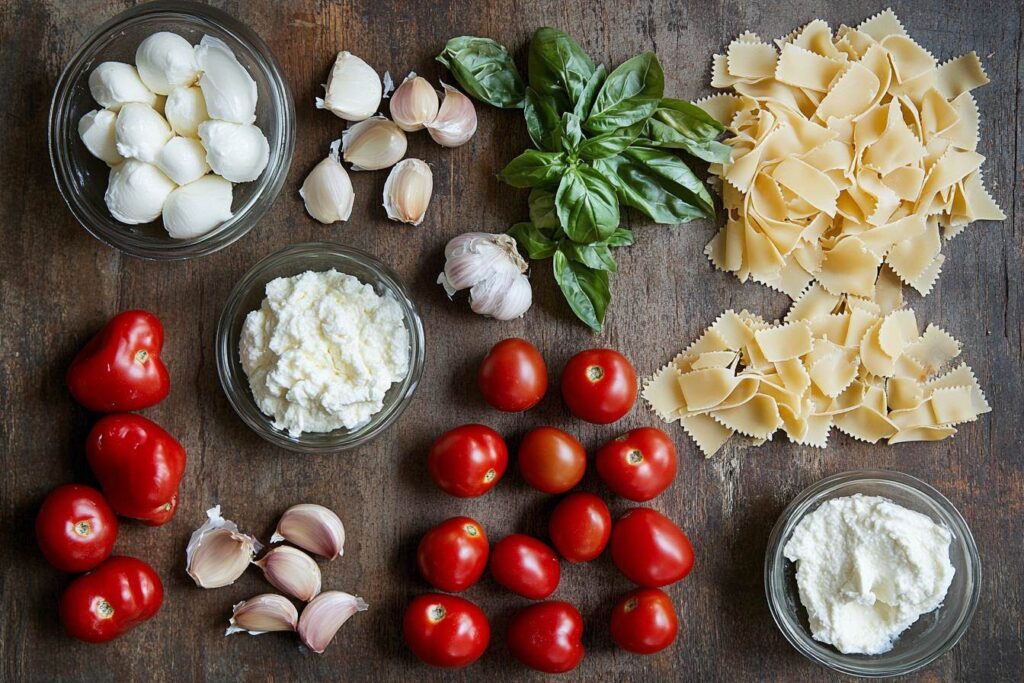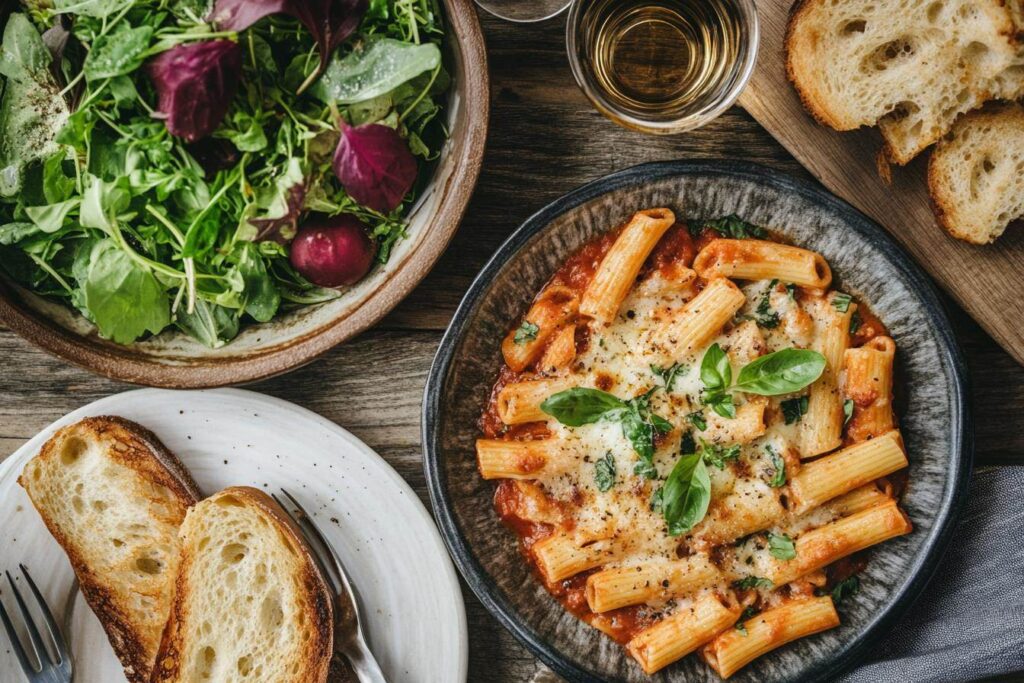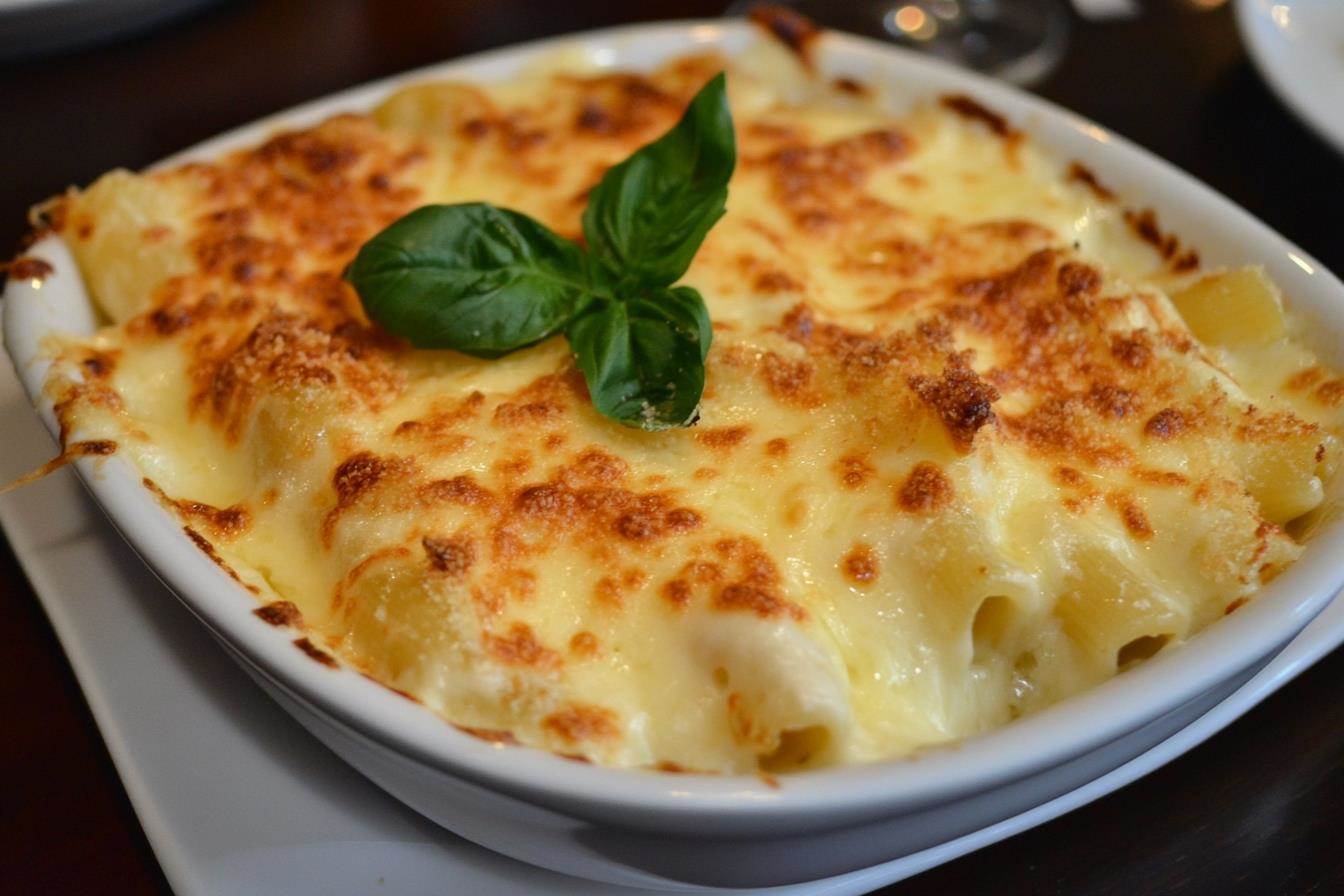Pasta al Forno is much more than just a baked pasta dish; it’s a celebration of Italy’s love for comforting, hearty meals that bring families together. This iconic dish combines layers of pasta, rich sauces, and melted cheese to create a masterpiece straight from the oven. Whether you’re savoring the classic Sicilian version or adding your modern twist, Pasta al Forno always delivers satisfaction. In this article, we’ll explore its origins, traditional recipes, variations, and expert tips to help you master this Italian treasure at home. Let’s dive right into the world of Pasta al Forno!
Introduction to Pasta al Forno
What is Pasta al Forno?
Pasta al Forno translates to “oven-baked pasta” in English. Without a doubt, it is a quintessential Italian comfort food, loved for its layers of flavor and textures. For instance, imagine pasta coated in savory sauces, blanketed with a mixture of cheeses, and baked to perfection with a golden, bubbly top. Originally from Italy, this dish has become a global favorite, praised for its versatility and soul-warming appeal. Whether it’s served at family dinners, used for celebrations, or prepared for indulgent moments, Pasta al Forno embodies the essence of Italian tradition.
History of Pasta al Forno
The roots of Pasta al Forno trace back to Italy, where baking pasta was a practical way to repurpose leftovers into a hearty meal. While its exact origin is debated, regional versions have emerged over time, each adding a unique twist. For instance, the Sicilian version of this baked pasta dish often features eggplants, while Neapolitan styles incorporate meatballs. These regional adaptations highlight the ingenuity of Italian cooks who embraced local ingredients and flavors to create truly distinctive dishes.
The dish also gained prominence as a celebratory meal in Italy, often served on Sundays or during holidays. Today, this baked pasta recipe is a global favorite, symbolizing the warmth and generosity of Italian cuisine.
Essential Ingredients and Variations
Traditional Ingredients
The heart of any Pasta al Forno lies in its carefully selected ingredients, which work together to create a comforting yet indulgent dish.
- Pasta Types: Traditionally, short pasta like rigatoni, penne, or ziti is used. These shapes hold the sauce well and bake evenly without becoming too mushy.
- Sauces: The most common base is marinara or a slow-cooked ragu, made with tomatoes, garlic, onions, and sometimes minced meat. A creamy béchamel sauce is also popular for layering richness.
- Cheeses: Cheeses are essential for the signature gooey, bubbly top. Mozzarella, ricotta, and parmesan are commonly used, with the latter providing a nutty, salty finish.
- Meats: Ground beef or Italian sausage is often added for depth. Meatballs or cured meats like pancetta can also be incorporated for a luxurious feel.
- Spices and Herbs: Garlic, basil, oregano, and parsley are essential for authentic Italian flavor. A pinch of nutmeg in béchamel or a sprinkle of crushed red pepper can elevate the dish’s taste.

Optional Ingredients and Modern Twists
For those who love experimenting in the kitchen, this baked pasta dish serves as a perfect canvas for innovation.
- Vegetarian and Vegan Alternatives: Skip the meat and swap traditional cheeses for plant-based options. Add roasted vegetables like zucchini, bell peppers, or mushrooms for extra flavor and texture.
- Exotic Flavors: Enhance the dish with gourmet additions like truffle oil, saffron, or sun-dried tomatoes. These ingredients add sophistication and depth, making the dish suitable for special occasions.
Selecting High-Quality Ingredients
The quality of your ingredients can make or break your Pasta al Forno. To create a truly authentic dish, follow these tips:
- Choose fresh, ripe tomatoes or high-quality canned ones for your sauce.
- Opt for pasta made from 100% durum wheat semolina for its firm texture.
- Invest in Italian cheeses like Parmigiano-Reggiano and fresh mozzarella for authentic flavors.
- Whenever possible, purchase herbs fresh rather than dried for a brighter taste.
Selecting the right components is the first step to crafting a mouthwatering Pasta al Forno. Remember, even the simplest dishes shine when prepared with care and quality.
How to Make Pasta al Forno
Step-by-Step Preparation Guide
Creating the perfect Pasta al Forno involves a few straightforward steps, but attention to detail is key. Here’s how to bring this Italian classic to life:
- Cooking the Pasta Correctly: Start by boiling your chosen pasta in salted water until it’s just al dente. This ensures it retains its shape and doesn’t become mushy during baking. Remember, the pasta will cook further in the oven, so undercooking it slightly is ideal. Drain and toss the pasta with a bit of olive oil to prevent sticking.
- Preparing the Sauce:
- Marinara Sauce: For a simple, vibrant option, simmer tomatoes with garlic, olive oil, and fresh basil.
- Ragu: A slow-cooked meat sauce made with ground beef or sausage, onions, and tomato paste delivers a rich, hearty flavor.
- Bechamel: Whisk butter, flour, and milk together until thickened, then season with a pinch of nutmeg. Bechamel adds creaminess to every bite.
- Layering and Assembling the Dish: Spread a thin layer of sauce at the bottom of your baking dish to prevent sticking. Layer cooked pasta, sauce, and cheeses (mozzarella, ricotta, or parmesan) in alternating layers. Repeat until the dish is full, ensuring the final layer is topped with cheese for that signature bubbly crust.
Baking Techniques for Perfect Results
Baking Pasta al Forno is where the magic happens. To ensure success, follow these tips:
- Optimal Oven Temperatures and Timing: Preheat your oven to 375°F (190°C). Bake uncovered for about 25–30 minutes or until the top is golden and bubbly. If the cheese browns too quickly, cover the dish loosely with foil.
- Achieving a Golden, Crispy Top: To get a crisp, caramelized crust, broil the dish on high for the last 2–3 minutes. Keep a close eye on it to avoid burning.
Common Mistakes and How to Avoid Them
Even seasoned cooks can encounter a hiccup or two when making Pasta al Forno. Here’s how to sidestep common pitfalls:
- Overcooked Pasta: Remember to cook pasta just al dente. Overcooked pasta turns mushy in the oven.
- Unbalanced Flavors: Ensure your sauce is seasoned well before assembling the dish. A bland sauce leads to a bland bake.
- Burnt Crust: Keep a close watch during baking and broiling. Covering with foil if needed can help regulate browning.
With these steps and tips, your Pasta al Forno will emerge from the oven irresistibly delicious, with layers of flavor and texture that are sure to impress!
Variations of Pasta al Forno
Classic Regional Recipes
Italy’s love for Pasta al Forno shines through its diverse regional variations, each adding its local flair to this beloved dish.
- Sicilian Pasta al Forno:
This version is hearty and full of bold flavors. It often includes eggplant, peas, and hard-boiled eggs, layered with meat ragu, mozzarella, and breadcrumbs for a rustic, crunchy topping. Sicilians also love incorporating caciocavallo cheese, a local specialty that adds a distinct tanginess. - Neapolitan-Style Pasta al Forno:
Naples brings a rich twist by including mini meatballs, ham, and provolone cheese. This variation embraces abundance, combining several types of cheeses and a slightly sweeter tomato sauce. A hallmark of the Neapolitan version of this baked pasta dish is the use of penne or rigatoni to create a structured, filling dish perfect for celebrations.
Health-Conscious Variations
For those seeking a lighter take on Pasta al Forno, there are plenty of options to enjoy this classic without overindulgence.
- Gluten-Free and Low-Calorie Recipes:
Swap traditional pasta for gluten-free options like brown rice pasta or chickpea pasta. Use low-fat mozzarella and ricotta to reduce calorie content while keeping the dish flavorful. - Keto-Friendly Options:
For a keto twist, replace pasta with zucchini noodles or spaghetti squash. Pair with a rich Alfredo or creamy tomato sauce made with heavy cream to stay within keto guidelines.
Fusion and International Adaptations
The adaptability of Pasta al Forno has inspired creative spins worldwide, blending local flavors and ingredients.
- Seafood Variations:
In coastal areas, seafood is added for a luxurious twist. Think shrimp, scallops, or chunks of white fish paired with a creamy béchamel or tomato sauce. - Global Flavors:
Incorporate curry spices, miso, or even shredded chicken tikka for a fusion take. These unique ingredients create exciting layers of flavor while retaining the comforting essence of the dish.
From authentic Italian recipes to innovative twists, Pasta al Forno proves it’s a dish for everyone. Experimenting with these variations ensures you’ll never tire of its deliciousness!
Presenting a Beautiful Dish
Ideal Pairings with Pasta al Forno
To elevate the experience of enjoying Pasta al Forno, pairing it with the right sides and beverages can make all the difference.
- Beverage Pairings: While traditional Italian wines often accompany Pasta al Forno, non-alcoholic options like sparkling water with lemon or iced tea infused with fresh herbs also complement the dish. Light and refreshing drinks balance the richness of the baked pasta.
- Best Side Dishes:
- Salads: A crisp, vibrant salad featuring arugula, cherry tomatoes, and a tangy vinaigrette provides a refreshing contrast to the hearty dish.
- Breads: Warm, crusty Italian bread or garlic bread is perfect for scooping up leftover sauce.
- Vegetables: Roasted or steamed seasonal vegetables like asparagus or zucchini make a delightful accompaniment.
Presentation Tips
The way you serve Pasta al Forno can enhance its appeal, whether for casual family dinners or formal occasions.
- Family Dinners: Serve the dish straight from the baking dish to highlight its rustic charm. A sprinkling of fresh basil or parsley adds a pop of color and freshness.
- Formal Gatherings: Plate individual portions neatly with a drizzle of extra sauce on the side. Garnish with grated parmesan and a sprig of basil for an elegant touch.
By pairing it thoughtfully and presenting it with care, you can ensure Pasta al Forno shines as the centerpiece of any meal.
Pasta al Forno in Modern Culture
Popularity Around the World
From its humble beginnings in Italian kitchens, Pasta al Forno has gained widespread recognition and adoration worldwide. In fact, its universal appeal lies in its adaptability to different tastes and preferences. For example, across Europe, the dish is a staple at Italian restaurants, often customized with local ingredients to suit regional palates. Meanwhile, in the United States, it has become a comfort food, frequently featured at potlucks and family dinners. Clearly, this iconic baked pasta has found a special place in the hearts of food lovers everywhere.
In addition, this baked pasta dish has found a home in global fusion cuisine. Variations featuring Asian spices or Middle Eastern influences are becoming increasingly popular, showcasing its versatility. Whether it’s a traditional Italian recipe or a creative adaptation, this comforting dish continues to symbolize warmth and indulgence.
Pasta al Forno in Restaurants vs. Home Cooking
The experience of enjoying Pasta al Forno at a restaurant versus making it at home offers distinct pleasures.
- Restaurant Versions: Italian eateries often elevate the dish with premium ingredients like imported cheeses or house-made sauces. The presentation is typically more refined, and the dish is baked in specialized ovens for a perfectly crisp top.
- Homemade Versions: At home, this baked pasta dish becomes a personal creation. You can modify the recipe to meet dietary needs or simply use ingredients you already have in your pantry. The comforting aroma of pasta baking in your kitchen adds a uniquely heartwarming charm to the experience.
FAQs About Pasta al Forno
What does “Pasta al Forno” mean in English?
The phrase Pasta al Forno translates directly to “oven-baked pasta” in English. In essence, it refers to a hearty Italian dish where pasta is baked in the oven. Typically, it is layered with sauces, cheeses, and often meats, resulting in a golden, bubbling top. Moreover, this dish embodies comfort and flavor, making it a staple in Italian households. Without a doubt, this classic baked pasta dish is a delightful addition to any meal, bringing both warmth and satisfaction to the table.
Can I prepare Pasta al Forno in advance?
Absolutely! This baked pasta dish is a fantastic make-ahead option. Simply assemble the layers in your baking dish, cover tightly with foil or plastic wrap, and refrigerate for up to 24 hours before baking. When you’re ready, bake it straight from the fridge, adding 10–15 extra minutes to the cooking time for the best results.
What’s the best pasta type for Pasta al Forno?
Short, tubular pasta, such as rigatoni, penne, or ziti, is perfect for this baked dish. These shapes not only hold the sauce beautifully but also stack neatly, ensuring even baking. As a result, every bite offers a satisfying texture and balanced flavors. Additionally, their sturdy structure prevents the dish from becoming overly mushy while baking, making them an excellent choice for this classic Italian favorite.
How do I prevent Pasta al Forno from drying out?
To keep the dish moist, ensure the pasta is generously coated in sauce before baking. Cover the baking dish with foil for the first 20 minutes to trap moisture, then uncover it for the last 10 minutes to allow the top to brown beautifully. For added moisture and flavor, consider sprinkling extra cheese or drizzling more sauce on top before baking.
What is the difference between Pasta al Forno and lasagna?
While both dishes are baked pasta classics, they differ in structure and ingredients. Lasagna is made with flat pasta sheets layered with sauces and fillings, whereas this baked pasta dish uses shorter varieties like rigatoni or penne. Additionally, the oven-baked option tends to be more versatile in its ingredient combinations.
Conclusion

Pasta al Forno is more than just a dish; it’s a timeless celebration of Italian cuisine that warms both the heart and the table. Indeed, its appeal lies in its versatility—whether you prefer the classic Sicilian version, a health-conscious twist, or an adventurous fusion, there’s a style to suit every palate. Additionally, with its layers of tender pasta, flavorful sauces, and melted cheese, it’s no wonder this baked pasta dish has earned a cherished place on dinner tables around the world.
Moreover, making this iconic baked pasta dish at home is an opportunity to create something truly special. From the moment you select the finest ingredients to the second you savor the aroma as it bakes, every step adds to the joy. So, why not give it a try? After all, gathering your ingredients, following the steps, and serving a meal that’s as comforting as it is delicious is incredibly rewarding. Mangiamo!


1 thought on “Pasta al Forno: The Ultimate Guide to Italy’s Favorite Baked Pasta Dish”